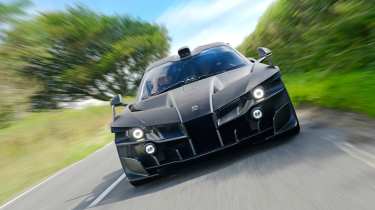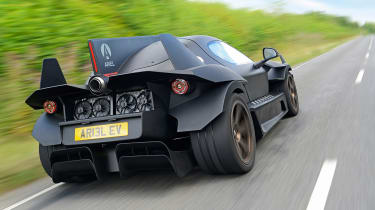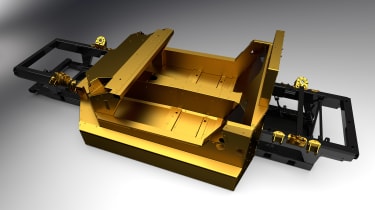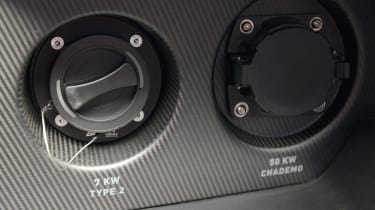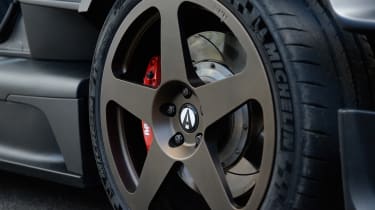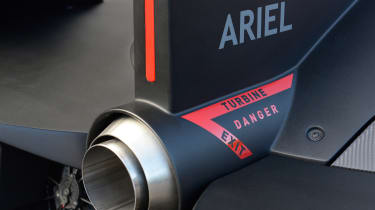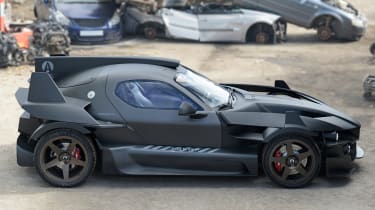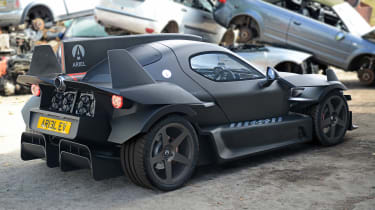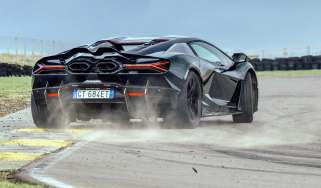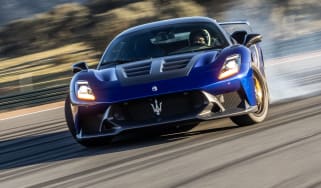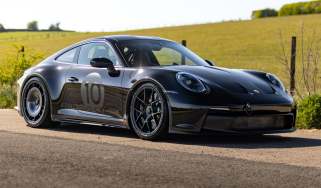New Ariel Hipercar revealed
British firm reveals 1180bhp carbon-bodied electric hypercar as it prepares for its EV future
Five years ago, we ran a news story describing Ariel’s plans to build ‘Hipercar’, an electric supercar. Maybe you missed it, or saw it and thought it a fanciful idea. After all, where does a tiny, Somerset-based brand producing around 100 cars per year find £14million to develop an EV supercar from scratch? Or, just as pointedly, where does it find the expertise? The answer to both of those questions is via government-funded bodies designed to propagate innovative technology that will help the UK’s ambition to get to Net Zero.
Now the Ariel Hipercar has been launched officially in all its 1180bhp glory. Hipercar stands for HIgh PERformance CArbon Reduction and now Ariel is able to share more detail of its first EV that has required close collaboration with a number of British based companies, including Cosworth.
A compact road car, it will weigh from 1445kg, is powered by four 295bhp motors fitted to each wheel, will have an EV range of 150 miles and the option of a range-extender in the shape of a catalytic generator, a compact micro-turbine running on whatever fuel is appropriate/acceptable. Those inboard electric motors on each wheel will allow Ariel to offer the option of two- or four-wheel drive, and will feature torque vectoring. It will also be capable of 20 minutes of intense running on a racetrack from a single charge.
Ariel Hipercar development process
‘Everything has gone through a lot of development since 2017,’ says Ariel boss Simon Saunders. ‘So the chassis and body are considerably more sophisticated, as are the battery, motors and control systems, but the basic idea and technical details are very broadly the same. An enormous amount of aerodynamic work has been carried out for both drag and downforce, and cooling, but we have stuck to our original cool battery concept.’
It’s quite the challenge for Ariel, which each year makes around 25 motorbikes and 100 Atoms and Nomads, cars with the bare minimum of features. Yet behind the scenes Ariel has been working on Hipercar since 2014. Why? ‘We could see the writing on the wall,’ says Saunders. He was involved in the design of the original, Elise-based Tesla Roadster and before that, in 2004, with the Wrightspeed X1, an Atom with an electric drivetrain designed by Ian Wright, a founder of Tesla. The X1’s performance was pretty good but not so good that people would have paid handsomely for it, says Saunders. ‘At the time, our supercharged car was faster and less than half the price. No-one was really interested in electric cars. “Yeah it’s slower but it’s greener” was going to be a difficult sell back then.’
> Caterham’s future sports car plans – will it go electric?
The tide has now turned. Ariel’s route to making Hipercar began with government-funded groups like the Niche Vehicle Network (NVN), a group bringing together car makers like Ariel, Caterham and BAC but also component manufacturers, engineers, aerodynamic consultants, battery and electric motor specialists and more.
‘There have been two projects: Hipercar 1, funded by Innovate UK, and Hipercar 2, funded by the Advanced Propulsion Centre,’ says Saunders. ‘They both fund R&D projects and competitions focused on zero emissions, taking ideas from concept to production-readiness. Part of that is lightweight efficiency and aerodynamics but also motors, batteries and associated technology. The government is funding this R&D to the tune of hundreds of millions, so when politicians say “we’ll have zero emissions by 2030” they’re backing that up with investment. And apparently the return from automotive – measured in emissions, turnover, jobs created, jobs safeguarded – is better than any other sector they fund, something like £15-20 back for every pound invested.’
Ariel has some big partners on Hipercar, including Johnson Matthey, which supplies exhaust catalysts to almost every car maker, and Semicron, experts in power electronics. Another is GKN Driveline. ‘A few years ago, GKN were all about selling gearboxes and support bits for the internal combustion engine,’ says Saunders. ‘If that goes, they’ve got an awful lot of employees, so they’re moving into electrification and doing really well. They’ve been involved in a lot of growth projects, so that money is safeguarding hundreds of jobs and keeping new technology in the UK.’
Despite being, as Saunders describes it, ‘an insignificant speck on the automotive face’, Ariel’s involvement has been well received and the learning has been really important for Hipercar.
‘We were part of another heavily funded R&D project called AMPLiFII, which was to design modular batteries for EVs. There were a lot of partners in it, from battery designers to people doing end-of-life stuff, and there were four OE manufacturers: Jaguar Land Rover, JCB, Alexander Dennis and us. It felt a bit like sitting at the teacher’s table. I said to Dave Greenwood, the guy running the project for the Warwick Manufacturing Group, that I felt a bit out of place and he said: “No, you’re brilliant because you’re the worst case scenario; you want most performance, least weight, highest range, you haven’t got any money for tooling and you want it really cheap, so if we can satisfy you…” The output from AMPLiFII has gone into Hipercar and many other EV projects.’
The other crucial element that small manufacturers bring to this funding model, says Saunders, is that it helps to bridge what Innovate UK calls ‘The Valley Of Death’. Saunders prefers to call it stepping stones. It represents the gap between very small companies, some of which maybe only have three or four people – but three or four very bright people who want to make motors, batteries, bits to support the drivetrain – and big car makers. ‘So on one side you’ve got Mr Boffin who has a high concept for a widget. On the other side, you’ve got, say, Ford Motor Company. They’re never going to talk to him and he’s too scared to talk to them. So Innovate UK is putting money into Ford but it’s also putting money into Mr Boffin, who takes his idea up to the next level, then the next level, and then goes into low-volume widget production. He sells us 100, he sells Caterham 400, he sells 1000 to a coach manufacturer. He’s now making a few thousand. And then Ford might say, “Could you do 10,000 for a low-volume Transit?”
‘So we are a stepping stone. The downside is that we’re the first stepping stone on a new technology, and everybody’s learning, so it’s not the most secure route and it’s also really expensive. So we have to be careful. Hipercar is gonna be an expensive car, purely because all the components are really expensive because they’re not available from very many places.’
An example of the stepping stone process in action is Delta Motorsport, another partner on Hipercar, which has many successful R&D projects under its belt and has now geared up for production of the battery packs and range-extender turbine. It has now been bought out by Cosworth. Not only does having a Cosworth drivetrain add cachet to Hipercar, says Saunders, it also gives Ariel a supplier with a proven record of delivering for production.
In the eight-year gestation of Hipercar, there have been many challenges. Today, specialists like Caterham and Morgan are wondering which EV technology to embrace, and Ariel will be in the same position when it comes to electrifying the Atom and Nomad, which is inevitable, says Saunders. But eight years ago things were even less certain. Ariel had to commit to a system and chose 800V, which was a big gamble as no one was at that level. ‘The reason these projects are funded is because there is risk involved,’ says Saunders. ‘They risk their money, we risk ours.
‘I forget what component it was we needed but the only 800V one we could find was used on trains and was the size of an armchair but heavier. Things are changing now manufacturers are indeed moving to 800V but lots of it is still hand-assembled and expensive, so Hipercar will be expensive. Not as expensive as a Rimac or Lotus but expensive, which is why it had to be a bodied car.’ On the subject of price, Ariel has confirmed a ‘sub-£1million’ price tag. Ouch indeed.
And because it’s an Ariel, it had to be track-capable, the most demanding test of an EV. ‘We’ve got about 10-12 simulations, which go from WLTP to one which is driving as fast as you can on a clear A-road, safely, with regen. We’ve got a turbine regenerator and you can drive like that all day, keeping the battery charged. But go to the track and no way; the power demand and heat generation is in another dimension. We showed some cooling experts the figures and they said, “No, you must have made a miscalculation,” so we went through the figures and they said, “Oh, ****, you’re right.” We solved that with a cooled battery and we’re now at the point where we reckon it will manage 20 minutes on track before the battery needs recharging, which is a session on a trackday.’ The battery is a 62.2kWh lithium ion unit.
This is one of the reasons that Hipercar missed its original launch date of 2020 but it’s also, says Saunders, because solving problems is ‘bloody difficult; the supply chain is in its infancy and the cutting-edge nature of the technology means we are in uncharted territory some of the time. Plus we are very finicky. One of the issues with performance has been traction, with the capability to spin wheels at more or less any speed, but with torque vectoring and the widest tyres ever seen on an Ariel we are overcoming this…’ Also, because Ariel has no dealers, it has to be reliable, bulletproof. ‘With the Atom and Nomad we give you the keys and say bye-bye. We don’t want to see it again until it’s time for service. The same has to be true for Hipercar.’
I get the impression that Saunders would like to become the Pagani of EV supercars, delivering a limited number of bespoke cars to customers who appreciate their capabilities and recognise that, in what is still the infancy of the electric supercar, bigger-name companies don’t have the monopoly on great ideas and execution. Exciting times.
Ariel Hipercar: in detail
Its chassis is a bonded aluminium tub, laser cut and CNC folded with removable front and rear subframes, which incorporate billet machined and anodised aluminium interfaces. Within this sits the sealed 62.2kWh lithium ion battery pack, itself wrapped in a ‘HyLight’ multi-material battery casing.
Hipercar’s striking bodywork is made from carbonfibre, the enclosed two-seater featuring forward opening butterfly doors that are power assisted requiring an electric release to both close and open them. Working with TotalSim, the body and floor have been optimised for aerodynamics, with the fins positioned on the front wings designed to reduce drag on the mirrors and the roof scoop supplying air to the turbine range extender. The shark fins on the rear of the car are there for stability.
Aluminium unequal length double wishbones are fitted at each corner, with adjustable anti-roll bars also standard. Bilstein has supplied the adaptive dampers (adjustable for compression and rebound) and the steering is power assisted, with 2.75 turns lock-to-lock. Michelin’s Cup 2 tyres will be standard, measuring 265/35x20 on the front, 325/30x21 on the rear, with the Cup 2R an option. The nine and 12.5-inch wide wheels are forged.
AP Racing will supply the brake system, which will feature six-piston calipers on the front axle, four on the rear. 370mm and 328mm diameter discs will be fitted front to rear. There will also be a regenerative braking system fitted, which can be switched on or off depending on the car’s use. An adjustable traction control system and torque vectoring will also be fitted, calibrated to suit both the four and two wheel drive powertrain options.
Talking of power, the four-wheel drive Hipercar will have four Equipmake APLM200 200kW (295bhp) motors, one fitted to each wheel, mounted inboard back to back. Each motor features a radial rotor architecture with magnets arranged on the outside of the rotor. This results in a power dense motor reducing magnetic material by around 25 percent, saving weight and material usage.
A single speed epicyclic 5.43:1 gearbox is integrated with each motor unit, featuring helical cut gears and asymmetric tooth profiles. An inverter and the power electronics are also fitted within the motor, with the close coupling of the inverter with the motor reducing transmission losses. Each motor, gearbox and inverter assembly weighs 57kg.
Power is provided by a Cosworth 62.2kWh battery pack, producing a maximum of 800 volts with a nominal 690 volt available. Nearly 6,000 cells fill the 32 modules to create high-power density cells that can draw up to 1450 Amps.
A liquid cooling system has been patented to manage the Hipercar’s battery temperature during track use. The system feeds refrigerated – or heated – water-glycol coolant directly to every cell pack, monitored by sensors.
Cosworth has also developed a micro-turbine range extender to charge the battery on the go. Powered by a catalytic exothermic reaction, the range extender runs at a fixed 120,000rpm and generates a continuous 35kW of power when required. Weighing less than 50kg, the unit independently monitors the battery’s state of charge, operating as and when required. It has been designed to run on a variety of fuels, including regular pump, synthetic and racing fuels.
Available with either rear or four-wheel drive, the former generates 590bhp, the latter 1180bhp with torque a claimed 662lb ft and 1342lb ft respectively. Opt for four-wheel drive and the weight is 1546kg (1445kg for the rear drive model), not that this hampers performance, with the 4WD car claimed to reach 60mph in 2.09 seconds, 100mph in 4.42 seconds and 60-120mph completed in 3.51 seconds. Top speed? 155mph.

